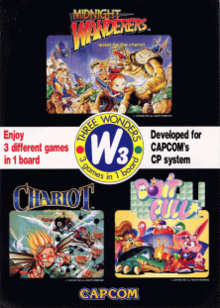|
Three Wonders
Three Wonders[a] is a 1991 video game compilation developed and published by Capcom for arcades.[1] It includes three related titles: Midnight Wanderers: Quest for the Chariot,[b] a platformer; Chariot: Adventure through the Sky,[c] a scrolling shooter; and Don't Pull,[d] a puzzle video game. Xing Entertainment released the game on the PlayStation and Sega Saturn under license from Capcom. GameplayMidnight WanderersA platform game that sees the player control a hobbit named Lou and his travelling companion, Siva, to run, climb, and shoot at enemies to fight a villain who is turning their people into wooden statues. ChariotA scrolling shooter game featuring the characters from Midnight Wanderers flying in their chariots to save their home planet and princess. Don't PullA puzzle game similar to games like the Adventures of Lolo series, Pengo, and Capcom's own puzzle game Pirate Ship Higemaru. It involves the player controlling either a rabbit named Don (Player 1) or a squirrel called Pull (Player 2), pushing blocks to crush monsters. Development and releaseThree Wonders was released in the arcades on May 20, 1991. A version for the Capcom Power System Changer was planned and previewed but never released.[2] In 1998, it was ported to the PlayStation and Sega Saturn and published by Xing Entertainment. Three Wonders was also included in the 2006 Capcom Classics Collection Vol. 2 on the PlayStation 2 and Xbox, Capcom Classics Collection Remixed on the PSP and Capcom Arcade 2nd Stadium. Characters from Three Wonders would go on to appear in other Capcom games. Lou appears in Marvel vs. Capcom: Clash of Super Heroes (1998) as an assist character. Siva was later adapted into the payable character Shiba Shintaro in Cannon Spike (2000). ReceptionIn Japan, Game Machine listed Three Wonders on their August 1, 1991 issue as being the fifth most-successful table arcade unit of the month.[3] Retro Gamer regarded Three Wonders as a good alternative to Biomechanical Toy.[4] GameFan reviewed the PlayStation version as inferior to the original arcade game due to bad quality converted graphics.[5] NotesReferences
External links |
||||||||||||||||||||||||||||
